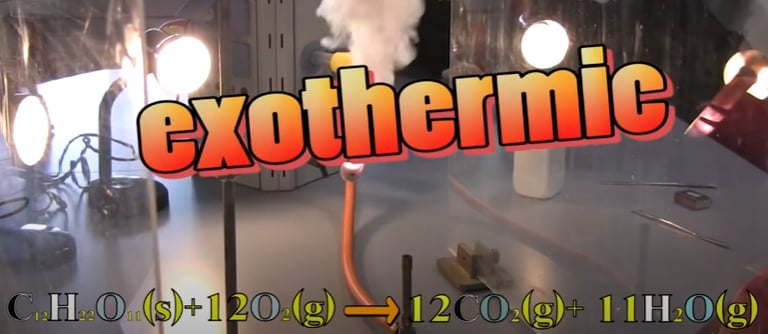
THE SCREAMING JELLY BABIES

The “screaming jelly baby reaction” is a demonstration of the exothermic reaction between a sugar-rich treats such as a jelly baby and molten potassium chlorate (V), a strong oxidising agent. The reaction produces a loud “screaming” sound, a bright white flame, clouds of smoke, and a caramel aroma (Hmmmmmm.... tasty! But don't eat them! No Jelly babies? Try a gummy bear instead if you prefer destroying sweet shaped bears instead of innocent jelly creatures. Watch the video to see those jelly kids suffer and then try the exercise below to see if you understand what is going on!
KNOWLEDGE TEST!
Yikes! There are some horrible chemical equations in the two pictures below which shows what happens in this reaction. Can you explain in your own words what is happening in each photo? Not sure? Hover over the images to find out.





There is lots of useful high school Chemistry occurring in this reaction. Great revision for assessments. These include:
• The concept of energy and how it is released when chemical bonds are broken and formed. The reaction is highly exothermic, meaning it releases a lot of heat energy to the surroundings.
• The role of oxidation and reduction in chemical reactions. The reaction involves the transfer of electrons from the jelly baby (the reducing agent) to the potassium chlorate (V) (the oxidising agent). The candy is oxidised, meaning it loses electrons and increases its oxidation state. The potassium chlorate (V) is reduced, meaning it gains electrons and decreases its oxidation state.
• The effect of surface area and concentration on the rate of reaction. The reaction is very rapid and vigorous because the candy has a large surface area exposed to the molten potassium chlorate (V), which is highly concentrated. This increases the frequency and effectiveness of collisions between the reactant particles, leading to a faster reaction rate. The reaction would be much slower and less dramatic if the candy was in a solid lump or if the potassium chlorate (V) was diluted.
• Health and Safety Gone Mad! The reaction is very dangerous and should only be carried out by teachers, or experts, in a well-ventilated room, with safety screens, eye protection, face shield, heat-resistant gloves, and tongs. The potassium chlorate (V) is oxidising, harmful, and toxic to aquatic life so make sure there are no fish of dolphins in the vicinity. It should be kept away from any combustible material or reducing agents. The reaction may also produce toxic gases such as chlorine dioxide and carbon monoxide, which should be dispersed quickly. To be honest, it's easier just to watch the video!




